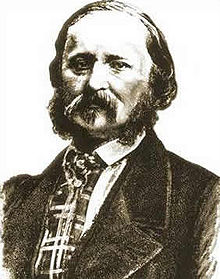Édouard-Léon Scott de Martinville
Édouard-Léon Scott de Martinville (born April 25, 1817 in Paris, † April 26, 1879 in Paris) was a French printer and bookseller living in Paris and is considered to be the inventor of the phonautograph .
Life
In 1857 he invented the first known device for recording sound, which he called the "phonautograph". In order to make sound visible, the phonautograph used a horn that was connected to a membrane , which created an image on a hand-cranked cylinder using a pig's bristle located there . Scott built several devices with the help of Rudolph Koenig , a local precision mechanics instrument maker. In contrast to the similar phonograph invented by Thomas Alva Edison in 1877 , the phonautograph was unable to reproduce the audiovisual recordings. Scott's invention was used solely for the scientific study of the representation of sound waves , but not for the reproduction and marketing of sound recordings, as Edison later practiced. Because it was used as an acoustic measuring instrument, in addition to the vibrations transmitted via the air, the vibrations of a tuning fork were recorded on a parallel track . This second track should be helpful for the later conversion of the lines into audible tones, since fluctuations in the sound track could be calculated due to the known constant frequency of the tuning fork.
Scott also published a book on the history of shorthand . In a retrospective 20 years later (1878) he reviled Edison: he had appropriated his (Scott's) methods and misused the recording technology. The goal is namely to write down language ( phonography ) and not to reproduce sounds. "What are the inventor's rights over those of the improver?" He wrote less than a year before his death. "Come on, citizens of Paris, let's not take our prize away from us."
In 2007, the historians David Giovannoni and Patrick Feaster discovered two phonautographs recorded by Scott in the documents of the French Patent Office from the years 1857 and 1859, which, however, were graphically distorted to be converted into tones. At the beginning of 2008, further phonautograms from 1860 were found in the archives of the Académie des Sciences , which Carl Haber and Earl Cornell of the Berkeley National Laboratory in California were able to reconstruct. One of these graphical records is dated April 9, 1860 and shows 10 seconds of the folk song Au clair de la lune . Due to unclear information in the original documents, an incorrect frequency of the reference track was initially assumed, which is why the voice was assigned to a woman; the inventor's can actually be heard.
Another find in the archives of the Société d'encouragement pour l'industrie nationale contains recordings from autumn 1857 and made it possible to reconstruct the earliest recordings of sound waves transmitted over the air, a scale played on a cornet .
Various records from the period 1853 to 1860 was in 2015 by the UNESCO for World Soundtrack Awards explained. However, these recordings were not submitted by France, but by the Association for Recorded Sound Collections (ARSC). The legacy is not attributed to France.
Web links
- Restored sound recording from 1860 (MP3; 169 kB)
- Restored sound recording from 1860 in the corrected version from 2010 (MP3)
- All sound recordings in chronological order (Youtube)
- Informal collaborative of audio historians - First Sounds - engl.
- Deutschlandfunk, broadcast of the historical calendar sheet on April 9, 2010
literature
- Greg Milner: Perfecting Sound Forever . The Story of Recorded Music. Granta Books, London 2009, ISBN 978-1-8620-7942-7 .
- Franz Joseph Pisko: The newer apparatus of the acoustics: For friends of the natural sciences and the art of sound . Gerold, Vienna 1865.
- Sandra Rühr: Sound documents from the roller to the audio book . History - media specific - reception. V&R Unipress, Göttingen 2008, ISBN 978-3-89971-473-9 .
- Patrick Feaster: Édouard-Léon Scott de Martinville: An Annotated Discography , ARSC Journal XLI, i 2010
Individual evidence
- ↑ Ulrich Stock: Der Klangfotograf , Zeit Online , March 15, 2007
- ↑ a b c Publications :: FirstSounds.ORG. In: www.firstsounds.org. Retrieved May 12, 2016 .
- ↑ Facsimile " Leproblemème de la parole s'écrivant elle-même " (p. 5)
- ↑ SpiegelOnline of March 27, 2008
- ↑ Humanity's First Recordings of its Own Voice: The Phonautograms of Édouard-Léon Scott de Martinville (c.1853-1860). UNESCO Memory of the World, accessed August 31, 2017 .
| personal data | |
|---|---|
| SURNAME | Scott de Martinville, Édouard-Léon |
| ALTERNATIVE NAMES | Scott, Leon |
| BRIEF DESCRIPTION | French inventor |
| DATE OF BIRTH | April 25, 1817 |
| PLACE OF BIRTH | Paris |
| DATE OF DEATH | April 26, 1879 |
| Place of death | Paris |
